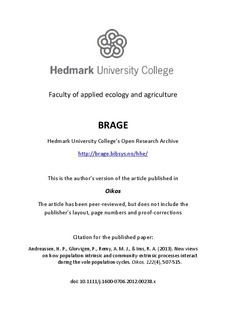New views on how population-intrinsic and community-extrinsic processes interact during the vole population cycles
Journal article, Peer reviewed
Permanent lenke
http://hdl.handle.net/11250/134498Utgivelsesdato
2013Metadata
Vis full innførselSamlinger
Originalversjon
Andreassen, H. P., Glorvigen, P., Remy, A. M. J., & Ims, R. A. (2013). New views on how population-intrinsic and community-extrinsic processes interact during the vole population cycles. Oikos, 122(4), 507-515. doi: 10.1111/j.1600-0706.2012.00238.x 10.1111/j.1600-0706.2012.00238.xSammendrag
Based on evidence from a series of recent studies linking behaviour to demography in experimental vole populations we propose how intrinsic and extrinsic factors interact through the various phases of the multi-annual population cycles of voles and lemmings. We hypothesise that population growth in the increase phase of the cycle is enhanced by a high degree of space sharing (sociality) among reproductive females who share resource patches, especially during winter. These social females enjoy a high reproductive output due to good resource conditions, and facilitation provided by communal thermoregulation, breeding and defence of weanlings towards infanticidal conspecifics. We hypothesise on the other hand that the crash phase is initiated and enhanced by predation of adult males that leads to a series of cascading events involving infanticidal behaviour by immigrant males, increased mortality of adult social females, and inversely density-dependent and/or disturbance-induced dispersal. These events further enhance predation-induced mortality and thus a negative feed-back loop to the rate of the crash. In this framework we may explain how extrinsic factors such as predation and winter resource distribution contribute to transitions between docile and aggressive behaviours, and how this transition is spatially synchronised by inversely density-dependent dispersal that may act to mediate a rapidly spreading wave throughout the population. We propose that innate differences among rodent species in their propensities for different social organizations also determine their propensity for exhibiting multi-annual cycles as well as other cycle-related phenomena such as shape of the population cycles and spatial synchrony. We provide a set of testable predictions for further empirical evaluation.
